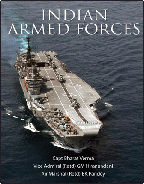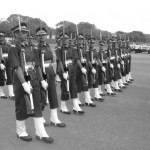The deliberations, in the 1970s, of the United Nations Conferences on the Law of the Sea led to the establishment of India’s Exclusive Economic Zone (EEZ).
On 25 August 1976, India passed the Maritime Zones Act which claimed a 12- mile territorial sea, a 24-mile contiguous zone, a 200-mile EEZ and a continental shelf up to 200 miles or the outer edge of the continental margin, whichever was greater.
Click to buy: Indian Armed Forces
This in turn led to the need for a force for safeguarding this zone.
 An interim Coast Guard was constituted on 1 February 1977 with two frigates and five patrol boats transferred from the Navy. Its tasks were to enforce India’s laws in the field of customs, immigration, poaching, and pollution at sea. It functioned under the aegis of the Navy until 1 August 1978.
An interim Coast Guard was constituted on 1 February 1977 with two frigates and five patrol boats transferred from the Navy. Its tasks were to enforce India’s laws in the field of customs, immigration, poaching, and pollution at sea. It functioned under the aegis of the Navy until 1 August 1978.
The permanent Coast Guard was constituted as an armed force of the Union on 19 August 1978, under the Coast Guard Act – 1978, which came into force on that day.
The Coast Guard Act – 1978
The Act specified the Coast Guard’s duties and functions:
- It shall be the duty of the Coast Guard to protect by such measures, as it thinks fit, the maritime and other national interests of India in the maritime zones of India.
- Without prejudice to the generality of the provisions of sub-section above, the measures referred to therein may provide for:
- Ensuring the safety and protection of artificial islands, offshore terminals, installations and other structures and devices in any maritime zone.
- Taking such measures as are necessary to preserve and protect the maritime environment and to prevent and control marine pollution.
- Providing protection to fishermen in distress at sea.
- Assisting the customs and other authorities in anti-smuggling operations.
- Enforcing the provisions of such enhancements as are for the time being in force in the maritime zones and
- Such other matters, including measures for the safety of life and property at sea and collection of scientific data, as may be prescribed.
- The Coast Guard shall perform its functions under this section in accordance with, and subject to such rules as may be prescribed and such rules may, in particular, make provisions for ensuring that the Coast Guard functions in close liaison with Union agencies, institutions and authorities so as to avoid duplication of effort.
The Maritime Zones of India (Regulation of Fishing by Foreign Vessels) Act 1981
Poaching is prevalent in the waters around the A&N Islands, in the approaches to the Hooghly River at the head of the Bay of Bengal, along the East coast between Visakhapatnam and Chennai, in the Palk Strait between India and Sri Lanka, along the West coast between Kochi and Mumbai and in the waters off the Gulf of Kachch.
The Regulation of Fishing by Foreign Vessels in the Maritime Zones of India Act came into force on 2 November 1981. It laid down the procedure to regulate fishing by foreign vessels in India’s EEZ and provided for deterrent punishments like levying fines, confiscation of craft, etc. for illegal fishing in the EEZ.
Concurrently, notifications were issued extending the provisions of the Criminal Procedure Code and the Indian Penal Code over the EEZ.
The Coast Guard thus became the principal organization for enforcing all national legislation in the Maritime Zones of India, and the policing, surveillance and patrolling of:
- The EEZ of 2, 013, 410 sq kms that extends 200 miles from the shoreline (1,418,193 sq kms EEZ of the mainland and Lakshadweep and 595,217 sq kms EEZ of the A&N Islands). The EEZ is expected to increase by about one million sq kms when the Legal Continental Shelf regime comes in to force.
- The Coastline comprising a total of 7,517 kms ( 5,423 kms of the mainland, 1,962 kms of the A&N Islands and 132 kms of the Lakshadweep Islands).
- The Island Territories (598 islands near the shore, 572 islands in the Andaman & Nicobar Group and 27 islands in the Lakshadweep Group).
- The Offshore Installations off Mumbai and the Tamil Nadu coast to ensure their security and, to avoid duplication of work, working in close liaison with other Government authorities
- The Territorial Waters that extend 12 miles from the shoreline and the 155,889 kms of the shoreline’s gulfs, bays, creeks, inlets and swampy marshy areas.
In the implementation of the above, the Coast Guard is:
- The national coordinating authority for Maritime Search and Rescue in the Indian Search and Rescue Region (ISRR). This region extends from longitude 60Ú East in the Arabian Sea to longitude 97Ú East in the Bay of Bengal down to latitude 6Ú South in the Indian Ocean and covers a region of over six million sq kms.
India shares Search and Rescue boundaries with:-
- Pakistan and Somalia in the West,
- Seychelles, Mauritius, Maldives and Sri Lanka in the South and
- Bangladesh, Myanmar, Malaysia and Indonesia in the East.
Coast Guard Resources
Surface Vessels
From 1983 onwards, in successive 5-year Plans, the Coast Guard has built up its resources in indigenously constructed offshore, inshore and fast patrol vessels, interceptor boats, interceptor craft and hovercraft. It has inducted Seaward Defence Boats, Offshore Patrol Vessels (OPVs) with Chetak helicopters embarked, Fast Patrol Vessels, Inshore Patrol Vessel and Interceptor Boats. It also operates and mans the Indian Oil Corporation’s fast interceptor boats at Vadinar.
The Coast Guard’s Air Wing
A helicopter squadron was commissioned in 1982 and a maritime surveillance squadron was commissioned in 1983.
Regional Organization
The structure that has evolved over the years is:
- Coast Guard HQ is at New Delhi.
- Three ‘Regional Headquarters’ at Mumbai, Chennai and Port Blair of the Western, Eastern and A&N Regions respectively. Each regional headquarters has under it ‘district headquarters’, Coast Guard Stations, Coast Guard Air Stations and Coast Guard Air Enclaves, Refit & Production Teams, Store Depots, etc:-
- The Western region comprises the coastal states of Gujarat, Maharashtra, Goa, Karnataka, Kerala and the union territories of Daman & Diu and Lakshadweep. The locations of the respective Coast Guard District Headquarters are Porbander in Gujarat, Mumbai in Maharashtra, New Mangalore in Karnataka, and Kochi in Kerala. Gujarat has a Coast Guard Station each at Vadinar and Okha.
- The Eastern region comprises the coastal states of Tamil Nadu, Andhra Pradesh, Orissa and Bengal. The locations of the respective Coast Guard District Headquarters are at Chennai in Tamil Nadu, at Visakhapatnam in Andhra Pradesh, at Paradeep in Orissa and at Haldia in Bengal. Tamil Nadu has a Coast Guard Station each at Tuticorin and Mandapam.
- The A&N Island region comprises these two groups of islands. The Regional Headquarters at Port Blair has under it the District Headquarters at Diglipur in the Andaman Islands and at Campbell Bay in the Nicobar Islands.
- The Coast Guard Air Station (West) is located at Daman, Coast Guard Air Station (East) is located at Chennai. There are Coast Guard Air Enclaves at Mumbai, Goa, Kolkata and Port Blair.
- There is a Coast Guard Berthing Jetty, a Base Maintenance Unit and a Stores Complex at Chennai and a Berthing Jetty at Visakhapatnam.
Activities in Peacetime
In peacetime, Coast Guard vessels
- Participate in the joint Navy-Coast Guard patrols in the Palk Bay, off the Maharashtra and Gujarat coasts and around the A&N Islands.
- Assist in cyclone, flood and earthquake relief operations.
The Coast Guard participates in a number of peacetime activities in these maritime zones which include joint Search and Rescue exercises and conferences on issues like piracy and Search and Rescue.
Over the years the Coast Guard has undertaken joint exercises with foreign Coast Guards:
- Coast Guard ships and aircraft have exercised with ships of Indonesia, Italy, Japan, Mauritius, Maldives, Seychelles, Singapore, Sri Lanka and Thailand.
- Since 1991, regular training exercises named ‘DOSTEE’ (Friendship) have been carried out with the Maldives Coast Guard to help enhance confidence levels and understanding on joint law enforcement, oil pollution response, search and rescue, etc.
The Coast Guard has interacted also with maritime organizations like the ASEAN Regional Forum Workshop on Maritime Piracy and the International Maritime Search and Rescue Conference.
In 2001, the Coast Guard reached out as far as Japan to participate in an Indo-Japan Coast Guard Exercise.
Overview of Achievements
The evolution of the Coast Guard has been remarkably cost effective. Most of its ships and aircraft are indigenous. With the Navy’s help, its manning and training have been extremely economical. Its anti-poaching operations, its anti-smuggling assistance to the Customs, its pollution-control operations, its protection to endangered marine species like the Olive Ridley turtles on the Orissa coast, its Search and Rescue Operations, its sustained round-the-clock surveillance in the shallow waters of the Palk Bay between Tamil Nadu and Sri Lanka, all have been invaluable.
From the time of its inception in 1978, the Coast Guard had, in round figures:
- Seized contraband worth over 300 crores of rupees.
- Apprehended over a hundred smuggling vessels, over eight hundred foreign poaching trawlers and over 8,000 of their crew.
- Responded to over 50 oil spill incidents and undertaken 30 oil spill operations.
- Interdicted over 20,000 illegal immigrants/infiltrators.
- Flown over 1,100 Search & Rescue sorties and saved over 1,500 lives at sea in over 750 missions.
Activities during Hostilities
As is done by other Coast Guards of the world, India’s Coast Guard would during hostilities, function under the overall operational command of the Navy.
 During the Kargil War in 1999 and during Operation Parakram in 2002, Coast Guard vessels and aircraft provided invaluable support to the Navy’s operations in the Arabian Sea.
During the Kargil War in 1999 and during Operation Parakram in 2002, Coast Guard vessels and aircraft provided invaluable support to the Navy’s operations in the Arabian Sea.
Directors General of the Coast Guard
To ensure the closest possible interaction between the Navy and the Coast Guard, the Directors General of the Coast Guard have been senior Vice Admirals, except briefly on two occasions in 2001 and 2005.




